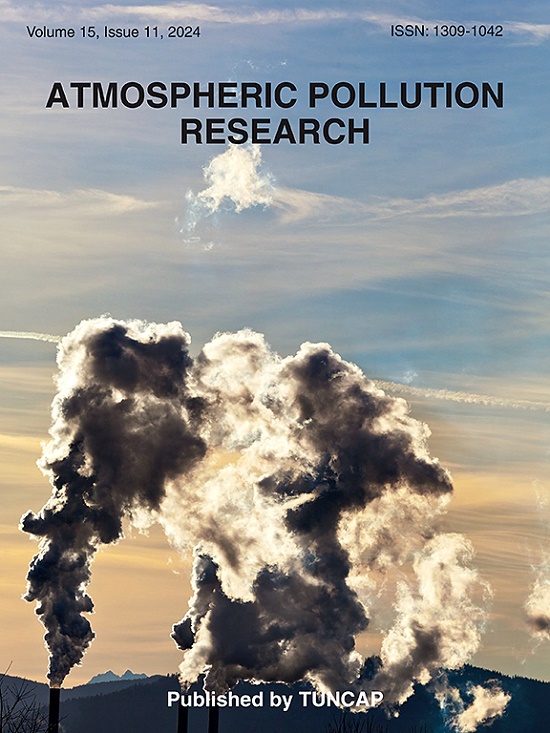利用AOD卫星数据和地面代用物估算马德里(西班牙)地面PM2.5浓度水平的两阶段算法
IF 3.5
3区 环境科学与生态学
Q2 ENVIRONMENTAL SCIENCES
引用次数: 0
摘要
城市地区空气质量差是一个重要的健康风险;因此,减少人们对PM2.5等污染物的暴露是一个主要问题。关于这种污染物的健康评估通常依赖于城市空气质量监测站网络的测量数据来评估人口暴露情况。用于观测空间插值的方法往往缺乏坚实的物理基础。中尺度空气质量模式根据城市特征(包括污染源的分布)提供高时空分辨率的地面浓度;然而,它们受到重大不确定性的影响。在这项工作中,提出了一种新的方法,用于制作2015年马德里市地面PM2.5浓度的1平方公里分辨率地图。为此,使用了不同的数据集,包括气象学、MAIAC大气光学深度(AOD)卫星观测、排放数据、人口、土地利用和植被覆盖。随后,我们分两步应用了极端梯度增强(XGBoost)机器学习算法,首先填补AOD领域的空白,然后估计地面PM2.5浓度。将所谓的2_step_XGBoost算法的预测结果与马德里空气质量监测系统所有可用的地面PM2.5浓度观测结果进行比较,得到决定系数(r2)为0.96,RMSE为1.5 μg/m3,偏差可以忽略。此外,我们使用10倍交叉验证来确认算法的稳健性和用于训练的数据集的独立性(r2为0.94±0.01,RMSE为0.40±0.04,MAE为0.22±0.02)。这些结果突出了该方法在未来城市健康分析中的可靠性。此外,我们进行了特征重要性(FI)分析,结果显示2_step_XGBoost将行星边界层高度(PBLH)确定为最具影响力的变量,而AOD的解释能力相对较低,这一结果可能会在其他案例研究中形成对比。本文章由计算机程序翻译,如有差异,请以英文原文为准。

A two-stage algorithm to estimate ground-level PM2.5 concentration levels in Madrid (Spain) from AOD satellite data and surface proxies
Poor air quality in urban areas is an important health risk; therefore, reducing population exposure to pollutants such as PM2.5 is a major concern. Health assessments regarding this pollutant have typically relied on the measurements from urban networks of Air Quality Monitoring Stations (AQMS) to assess population exposure. The methods used for the spatial interpolation of observation often lacks a solid physical basis. Mesoscale air quality models provide high spatiotemporally resolved ground-level concentrations based on urban features, including the distribution of pollution sources; however, they are subject to significant uncertainty. In this work, a novel methodology to produce 1 km2 resolution maps of ground-level PM2.5 concentration for the Municipality of Madrid during 2015 is presented. Toward this end, different data sets including: meteorology, satellite observations of atmospheric optical depth (AOD) from MAIAC, emission data, population, land use, and vegetation land cover have been used. Subsequently, we applied extreme gradient boosting (XGBoost) machine learning algorithms in two steps to first fill gaps in the AOD field and then, estimate ground-level PM2.5 concentration. The predictions of the so-called 2_step_XGBoost algorithm were compared with observations from the all available ground-level PM2.5 concentration observations from the AQMS in Madrid obtaining a determination coefficient (r2) of 0.96, a RMSE of 1.5 μg/m3, and negligible bias. Additionally, we used a 10-fold cross validation to confirm the robustness of the algorithm and the independency of the dataset used for training (r2 of 0.94 ± 0.01, RMSE of 0.40 ± 0.04 and MAE of 0.22 ± 0.02. These results highlight the reliability of this approach for future urban health analysis. In addition, we performed a Feature Importance (FI) analysis that revealed that 2_step_XGBoost identified the planetary boundary layer height (PBLH) as the most influential variable while AOD was found to have relatively low explanatory power, a result that may be contrasted in other case studies.
求助全文
通过发布文献求助,成功后即可免费获取论文全文。
去求助
来源期刊

Atmospheric Pollution Research
ENVIRONMENTAL SCIENCES-
CiteScore
8.30
自引率
6.70%
发文量
256
审稿时长
36 days
期刊介绍:
Atmospheric Pollution Research (APR) is an international journal designed for the publication of articles on air pollution. Papers should present novel experimental results, theory and modeling of air pollution on local, regional, or global scales. Areas covered are research on inorganic, organic, and persistent organic air pollutants, air quality monitoring, air quality management, atmospheric dispersion and transport, air-surface (soil, water, and vegetation) exchange of pollutants, dry and wet deposition, indoor air quality, exposure assessment, health effects, satellite measurements, natural emissions, atmospheric chemistry, greenhouse gases, and effects on climate change.
 求助内容:
求助内容: 应助结果提醒方式:
应助结果提醒方式:


